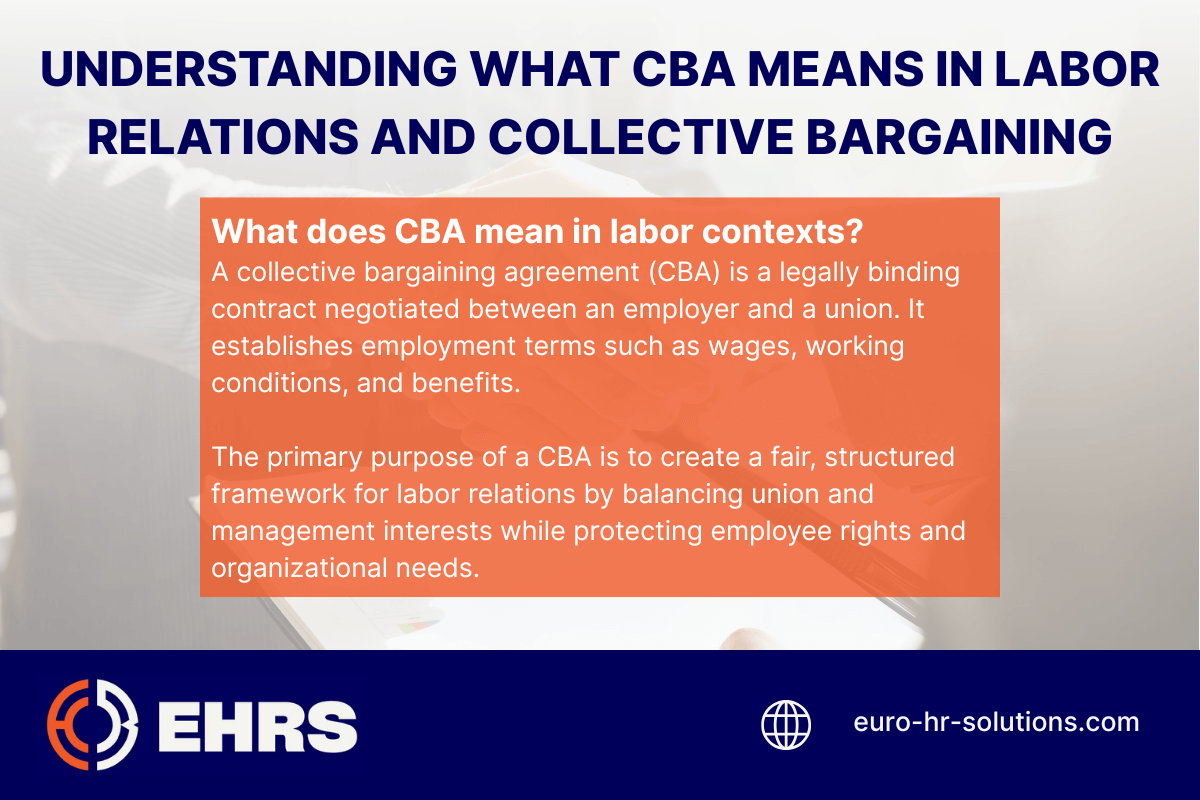Confused about what “CBA” truly means in labor contexts?
This guide demystifies Collective Bargaining Agreements, explaining how unions and employers negotiate important terms like payroll, benefits, and workplace conditions through structured processes.
You’ll also discover alternative meanings of “CBA” in business and slang, while gaining actionable insights into how these agreements shape modern employment landscapes and organizational strategies.
Understanding What CBA Means in Labor Relations and Collective Bargaining
What does CBA mean in labor contexts? A collective bargaining agreement (CBA) is a legally binding contract negotiated between an employer and a union. It establishes employment terms such as wages, working conditions, and benefits. The primary purpose of a CBA is to create a fair, structured framework for labor relations by balancing union and management interests while protecting employee rights and organizational needs.
The main parties in a CBA are the employer and the union representing employees. Union members elect representatives to negotiate on their behalf, while employers may be individual companies or industry associations. These agreements formalize the relationship by outlining mutual obligations, dispute resolution processes, and workplace standards. Collective bargaining agreements ensure both sides operate within agreed parameters, reducing conflicts and providing legal recourse when necessary, which is crucial for effective HR Compliance. This structured approach promotes workplace stability and predictable labor relations.
What does CBA mean outside labor contexts? The acronym has multiple interpretations. In British slang, “CBA” often means “Can’t Be Arsed” – a casual way of expressing disinterest. In business, it might refer to cost-benefit analysis. The Consumer Bankers Association (CBA) represents financial institutions, while in sports, the National Basketball Association (NBA) has its own CBA. These alternative meanings highlight the importance of context when interpreting the acronym.

Key Components Typically Included in a Collective Bargaining Agreement
| Element | Description | Purpose |
| Wage Standards | Minimum pay rates, overtime compensation | Establish fair payroll practices |
| Work Hours | Daily/weekly schedules, break requirements | Define working time expectations |
| Leave Policies | Sick, vacation, parental leave provisions | Standardize time-off terms |
| Benefits | Health insurance, pension plans | Ensure equitable employee support |
| Grievance Procedures | Conflict resolution mechanisms | Address workplace disputes systematically |
| Disciplinary Rules | Performance expectations, sanctions | Maintain professional standards |
| Contract Duration | Agreement period, renewal terms | Establish agreement process |
The CBA Process: Union Negotiations and Agreement Formation
The collective bargaining process begins with a formal notice from the union or employer. This triggers mandatory negotiations to address terms like wages and working conditions. Both parties exchange proposals and gather financial data. Preparation includes analyzing past agreements and defining priorities. For renewals, notices often precede expiration by 90 days, while new CBAs follow union certification.
Key stages in collective bargaining agreements negotiation:
- Initiation of Negotiations: Formal notice of negotiation triggers the CBA process, setting timelines for discussions and preparing both parties for collaborative bargaining.
- Exchange of Proposals: Employer and union submit their priorities, creating a structured framework for resolving disputes over wages, benefits, and workplace policies.
- Mediation and Dispute Resolution: Neutral third parties facilitate dialogue to address unresolved issues, aiming to prevent strikes or lockouts through impartial guidance.
- Ratification by Union Members: Final agreements require majority approval from union staff, ensuring democratic validation of negotiated terms before implementation.
Ratification requires union members to vote on proposed CBAs. A majority (over 50%) must approve the agreement for it to pass. If rejected, parties may pursue mediation, adjust terms, or face potential strikes. For instance, the American Postal Workers Union mails ballots to members for voting. Even expired agreements often maintain previous terms during renegotiations, as seen with orchestras continuing under expired contracts.
CBAs typically last 3-5 years, with renegotiation starting months before expiration. Employers and unions review financial data, define objectives like wage adjustments, and assess member priorities. For example, NBA collective bargaining agreements often span 4-5 years, like Stephen Curry’s record contract extension. When expired, existing terms generally persist until replaced, ensuring continuity for workers and employers.
CBA Impact on Employee Benefits, Payroll, and Working Conditions
Collective bargaining agreements (CBAs) establish structured wage frameworks, including base pay rates, overtime compensation, and periodic adjustments. For employee purchasing power during inflation. By mandating transparent The hidden costs of hiring.
CBAs comprehensively regulate benefits packages, covering health insurance, retirement plans, and paid leave. union workers receiving employer-sponsored health coverage versus 69% in non-union environments. Retirement plans typically include defined-benefit pensions, while paid time off provisions frequently exceed statutory minimums. These agreements also address disability protections and supplemental unemployment benefits, creating a robust safety net for covered Cultural differences can further illuminate how these benefits are valued and structured across various regions.
Common workplace policies governed by collective agreements include:
- Working Conditions: payroll practices for employees.
- Non-Monetary Protections: Include seniority rules, job security clauses, and protections against arbitrary disciplinary actions.
union workers by setting industry benchmarks. When terms can challenge organizational flexibility, requiring formal renegotiations for policy changes. EU compliance frameworks frequently intersect with CBAs, shaping labor standards across jurisdictions.
Understanding what a Collective Bargaining Agreement (CBA) entails—its role in uniting union and employer interests, structuring fair labor terms, and shaping workplace standards—is important for informed negotiations. By grasping its key components and processes, stakeholders can approach agreements with clarity, ensuring equitable outcomes. For any workforce, this knowledge isn’t just beneficial—it’s foundational to fostering sustainable, respectful labor relations.
Frequently Asked Questions (FAQ)
What does CBA mean over text?
Over text, CBA is an acronym that primarily stands for “can’t be arsed.” This phrase is a common piece of British slang, also widely used in Australia and New Zealand. It conveys a *lack of energy, willingness, or enthusiasm* to do something, indicating that a person cannot be bothered or does not want to make the effort.
The term “arsed” in this context is a British slang equivalent of “ass,” and the overall expression signifies a feeling of *disinterest or extreme reluctance*. It is typically reserved for informal conversations with close friends due to its casual and somewhat vulgar nature.
What is CBA in messaging?
In messaging, CBA predominantly means “can’t be arsed,” a British slang expression used to indicate a *lack of energy or desire* to undertake an activity or task. This meaning is also prevalent in Australia and New Zealand, signifying that one is too tired, lazy, or simply unwilling to do something.
The acronym is frequently employed in *text messages and on social media platforms* such as Snapchat, Instagram, and X/Twitter. A more polite alternative with the same meaning is “can’t be asked,” which some use to avoid the term “arsed,” considered vulgar. Given its informal nature and the inclusion of a coarse word, CBA is best used in casual conversations rather than formal or professional settings.
What is CBA slang for Snapchat?
On Snapchat, CBA is an informal acronym that stands for “can’t be arsed.” This British slang phrase is also commonly used in Australia and New Zealand, conveying a *lack of energy, will, or desire* to engage in an activity. It generally implies being too lazy or tired to do something, or simply not wanting to do it.
The term “arsed” within this expression means to be “bothered” or “annoyed.” While “can’t be asked” is a more polite alternative used by some, CBA remains an informal term due to the vulgarity of “arsed.” It is typically used in *casual exchanges with close friends* to express an unwillingness to participate or a general fatigue.
What does CBA stand for in TikTok?
On TikTok, the acronym CBA primarily signifies “can’t be arsed.” This informal expression is widely used to indicate a *lack of energy, desire, or willingness* to do something. It is particularly widespread in British, Australian, and New Zealand contexts, often appearing in phrases like “I cba to go to work today” or simply “Cba” to convey weariness or disinterest.
The term “ceeebs” is even used as a shortened form of CBA, further highlighting its casual usage. While CBA has other meanings in specific contexts, such as “Collective Bargaining Agreement” in sports, its common and informal use on TikTok refers to “can’t be arsed,” serving as a *common text abbreviation* to express reluctance.





